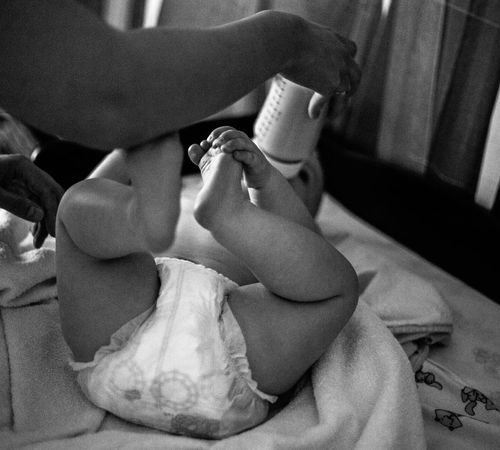How to wean your child step-by-step and extra tips to ditch those night feeds
Night weaning is a big step for both parents and children. While it might strike a fear, you are probably also ready for finally uninterrupted nights. What you first have to understand about sleeping through the night is that it is not only an issue of nightly feeds but also a developmental milestone. Night wakings in young children are perfectly normal. Sleep regressions, leaps, illness, or the emotional need for comfort are other pretty normal reasons for wakings besides hunger.
But there is also the other truth that night weaning may indeed lead to more consolidated baby sleep at night. Especially with growing age, night feedings can become the preferred comfort mechanism to fall back to sleep for older babies (or, let's just call it a sleep association).
While some babies wean themselves, others may need a little push in the right direction. It's totally ok to consider night weaning and not to wait for it to happen naturally. Please be aware that night weaning is not a guarantee that your baby will sleep through the night, especially when they are younger (< 1 year). Before you start the night weaning process, there are several things to consider:
Is your baby ready?
There are a lot of different opinions on when babies can drop nighttime feedings. But the truth is that there is no right age to start weaning. In the end, your child has to be ready for this step. There are several signs to tell if it's the right time for your baby. Obviously, they are not conclusive since every child is different. But they work as good guidelines.
Many will say that starting at 6 months, babies get enough calories during the day and don't need any feeds at night anymore. However, as mentioned before, babies do not solely wake from hunger. They have other valid emotional needs that need to be met when your child awakes at night. Therefore, mental development is a big factor when it comes to weaning. If your little one hasn't reached that milestone yet, night weaning will not result in fewer wakings. If after a week of trying, you don't see any progress at all, it may be better to drop it for the time being and start again in a month or two.
Two other factors are an appropriate weight and age. Ideally, your little one should be on 3 solid meals a day so you can rule out hunger for sure. It is always helpful to consult with your pediatrician. They can tell you if your child has the appropriate weight and shows appropriate growth for her age to stop overnight feedings.
Weaning babies under the age of 1 can also be tricky because there is a high chance they are waking for reassurance from a caregiver. Often, those babies will still wake at night even after weaning and will have to be comforted in another way.
If your little one is already sleeping for longer stretches at night (3-4 hours), it is a good indication they can go for more. However, if your baby is waking every 1-2 hours, you may want to try stretching those times first. For example, you could change sleeping arrangements, e.g., moving into own room or weaning from single feeds to get a longer stretch of sleep.
Hunger or habit?
It's not that easy to determine if your baby is actually hungry or if they are using breastfeeding as a way to fall back to sleep. I cannot tell you how often I breastfed my babies at night and was starving! While you can never really tell if your baby is truly hungry or not, having good solid meals during the day minimizes the chances that they are hungry at night. If your little one does not have full feeds, still cannot fall asleep after a good feed, or is not eating well in the morning, it indicates that they are probably using the feed as a way to settle. On the other hand, if they fall back asleep fast and are drinking well, they might still be hungry.
Obviously, you should never force-feed your child by adding as many meals as possible to the day. Unfortunately, there is this misconception that tanking a baby up right before bedtime will help them sleep. But a baby that is going to wake up is still going to wake up even without that extra serving of milk.
Are you ready?
If the time is right, the weaning process should no longer take than 3-7 days. But it's sometimes not such an easy process because you might a) experience some resistance from your baby, b) need to offer alternative soothing methods such as patting, rocking, and shushing with which your little one might take more time to fall back to sleep, and c) get even less sleep until your baby is weaned. Therefore, you should be ready to invest in the process and prepare your mind that it can be a hurdle. Ideally, both parents should be on board and ready to act. Depending on your child, teamwork might work better. If you have reservations and it results in inconsistent behavior from your side (denying one night and offering the other), it is better to delay the process of weaning for a little while. Otherwise, you will only confuse your child and end up fighting with no real improvement.
Consider thirst (but be cautious with alternatives)
Everybody is talking about hunger but have you also considered thirst? Many adults get up at night to drink some water, so why wouldn't your child? In that case, it is really helpful if your little one can already drink from a sippy cup. There are great cups that don't leak, and you can leave them in your child's crib. But you should be cautious about offering alternatives. Don't use a bottle to offer water. Even breastfed babies that used to refuse the bottle might find comfort in sucking from a bottle at night if it's the last resort for them. They might also get used to waking for water, not just milk. So make sure that your baby hydrates well during the day.
Prepare for weaning
There are some things you can do to prepare for a successful and easier weaning process.
1. Create a sleep-inducing environment
Make sure that your child's room has the right sleeping environment. Keep the room dark and cool. Use other tools like white noise and a sleeping bag to help your little one sleep better.
2. Eliminate/Wait out possible discomfort
Your child should be physically fit. Make sure they don't experience any discomfort from teething, reflux, or any other kind. Also they don't wake due to some kind of discomfort. If your child is going through a growth spurt, leap, or is experiencing major life changes (new sibling, start of daycare), you also want to delay night weaning.
3. Encourage eating during the day
After 4 months, babies get very interested in their surroundings. They might find everything more interesting than their daytime feeding. They snack here and there instead of having an actual full feed or meal. Get rid of any distractions and encourage eating well during the day.
4. Tank up on sleep yourself
Chances are that during the first few nights, your baby will wake more often. They might need a longer time to settle back to sleep. So if you find any time during the day, try getting that little extra sleep every time you can.
5. Consider changing sleeping environments
Deciding on the sleeping arrangements is a very personal family affair. And of course there is no right or wrong place for a baby to sleep. But sometimes the current sleeping arrangement can lead to extra wakings. Children that are co-sleeping or room-sharing with their parents can get stimulated by their presence and may tend to wake more often. Some babies are also very sensitive to noises. If you have already considered moving your little one into their own room in the near future, it is a good thing to do it before weaning. Obviously, you can also wean when bed- or room-sharing.
How to wean - the methods
Gradual or cold turkey?
In general, there are two methods: the gradual approach or going cold turkey. Depending on what your baby is getting, breastmilk or formula, their temperament, and their age, one approach may work better than the other.
The gradual approach works well for formula-fed babies, easy-going babies, and younger children (< 15 months). It usually takes a bit longer but can work with no crying involved. The cold turkey approach might work faster but come with protest. It is suitable for older babies (14+ months), babies high in temperament, and breastfed babies. You can always start with the gradual approach. If you see improvements, then it's a great way to wean.
Night weaning a breastfed baby 1 - the gradual approach
For the gradual approach, you will reduce the time your baby is nursing. The first few days track how long, in general, your baby is nursing at each side. And then every 1-2 days you will reduce the time by a minute. If your baby is only nursing for about 2 minutes, you can try to drop that feed completely.
If your baby still wakes up and she is only complaining, give her a few minutes. She might fall back asleep. If she starts crying, soothe her back to sleep, ideally without getting her out of the crib (e.g., sushing, patting on back). You will continue like this with all night feedings until you have dropped them all.
Night weaning a breastfed baby 2 - the cold turkey approach
Going cold turkey sometimes works better for breastfed babies, especially when they are older (14+ months). While they have day-night confusion figured out, they won't understand why they are sometimes offered the breast, but other times they are not. Older children can be prepared by explaining that days are for eating/drinking and nights are for sleeping. When completely stopping night feeds, daddy’s involvement can help a great deal. If after 3-4 days you see no improvement at all, either try the gradual method or delay night weaning for a month.
Night weaning a bottle-fed baby 1 - the gradual approach
When you apply the gradual method, you will decrease the amount of formula powder over the next few days bit by bit. The milk will get more watery, and your child will lose interest in the less tasty milk. Finally, you will replace it completely with water. Finally, you will replace the bottle with a sippy cup because you also want to wean them completely from the bottle. Another possibility is to decrease the amount of milk altogether until you don’t offer any bottle anymore. However, babies easily notice even 1/2 oz milk missing, so this only works for few babies.
Night weaning a bottle-fed baby 2 - the cold turkey approach
Going cold turkey with a bottle-fed child works practically the same as with a breastfed child. If daddy has also bottle-fed the baby at night, one of you will have to take over as the comforter and the other as the feeder. This will ease the process and be less confusing for your little one.
Night weaning tips and tricks
1. Start baby on a schedule
If you have not started your baby on a loose schedule yet, this may be a good opportunity. Timing is everything when it comes to sleep. The right time and amount of daytime sleep are extremely important to achieve good quality nighttime sleep. You will better prevent over and under tiredness, two main causes for frequent night wakings.
2. Include your partner
Including your partner in the weaning process can be extremely helpful. Babies and toddlers understand very well who is providing the milk and who is not. They often protest more when the feeding partner (bottle or breast) tries to comfort them. If the non-feeding partner takes over the first couple of days, your little one will quickly understand that there are no feedings at night anymore. If you have breastfed anyway at night, dad should take over this part.
3. Give extra attention during the day.
Babies might also use nighttime as an extra time for bonding. Especially when your little one is going to daycare, they miss out on extra time with you and will then try to compensate at night. Therefore make sure to give many extra cuddles and a lot of undivided attention during the day.
4. Prepare your child for the change
By the age of 1, your child understands approx. 50% of what you’re saying. By the age of 2, they understand everything. Verbal communication with your child is so important from a very young age. Always tell them what’s coming next. The same goes for night weaning. If you have an older child, explain to them that the night (“when it’s dark”) is for sleeping and the day (“when it’s bright”) is for eating. This does not necessarily mean your child is on board right away. But the more you explain it, the more they will understand and accept it.
5. Consider settling them in their sleeping space
While settling in bed does not directly influence your baby's need to feed at night, it might help you with reducing night wakings and creating new sleep associations by settling in different ways. But there is no guarantee, as your baby can differentiate very well between how they fall asleep and how you react to their wakings.
Nowadays, the pressure to night wean children as soon as possible is very high. Parents fear that if they don't night wean at the right time, they are setting their child's sleep up for failure, and they will never sleep. Often sleep consultants and sleep training methods will also claim that night weaning is necessary to improve your baby's sleep. But nothing is farther away from the truth. Night feedings are a normal part of nighttime parenting. Some parents are actually fine with getting up at night. Whenever you decide to wean, you will eventually get your uninterrupted sleep. Just do what feels right for you and your family.









